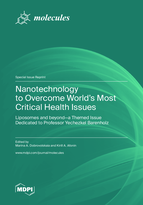Nanotechnology to Overcome World’s Most Critical Health Issues: Liposomes and beyond—a Themed Issue Dedicated to Professor Yechezkel Barenholz
A special issue of Molecules (ISSN 1420-3049). This special issue belongs to the section "Applied Chemistry".
Deadline for manuscript submissions: closed (31 January 2023) | Viewed by 29476
Special Issue Editors
Interests: immunology; toxicology; nanoparticles
Special Issues, Collections and Topics in MDPI journals
Interests: RNA nanobiology; drug delivery
Special Issues, Collections and Topics in MDPI journals
Special Issue Information
Dear Colleagues,
Please join us to celebrate Professor Yechezkel Barenholz’s distinguished achievements. Professor Barenholz is Professor Emeritus of the Hebrew University in Jerusalem, Israel. He joined the University faculty in 1968, received his PhD in 1971, and became Professor in 1981. He has worked and taught at leading universities worldwide throughout his career. One of the prominent achievements in Prof. Barenholz’s career is the development of a PEGylated liposomal doxorubicin formulation, known as Doxil®, that completely transformed care for cancer patients worldwide. Professor Barenholz’s research focuses on the biochemistry of lipids and membranes and biophysics laws underlying the fluidity of cellular membranes. Another focus area is the development of liposomes and lipid-based nanocarriers to overcome the shortcomings of current therapeutics by improving drug delivery. Professor Barenholz has authored more than 400 papers with an h-index of 94; he is also inventor of over 55 patents and an awardee of many prestigious national and international awards in the biomedical field. Professor Barenholz is highly regarded by his peers and students. One of the examples of his continuous contribution to the education of the next generation of scientists is the “Barenholz Prize” that supports Israeli PhD students in Applied Sciences and encourages their professional growth and innovation. Professor Barenholz has founded and is currently leading the steering committee of the Hebrew University School of Business Administration BioMed-MBA program, through which he organized an online platform that enables the Israeli BioMed ecosystem.
This themed issue invites original research papers and reviews articles describing a variety of nanotechnology platforms, including but not limited to liposomes for drug delivery, which are geared toward overcoming the world’s most critical health issues and supporting the sustainability of the environment.
Dr. Marina A. Dobrovolskaia
Assoc. Prof. Dr. Kirill A. Afonin
Guest Editors
Manuscript Submission Information
Manuscripts should be submitted online at www.mdpi.com by registering and logging in to this website. Once you are registered, click here to go to the submission form. Manuscripts can be submitted until the deadline. All submissions that pass pre-check are peer-reviewed. Accepted papers will be published continuously in the journal (as soon as accepted) and will be listed together on the special issue website. Research articles, review articles as well as short communications are invited. For planned papers, a title and short abstract (about 100 words) can be sent to the Editorial Office for announcement on this website.
Submitted manuscripts should not have been published previously, nor be under consideration for publication elsewhere (except conference proceedings papers). All manuscripts are thoroughly refereed through a single-blind peer-review process. A guide for authors and other relevant information for submission of manuscripts is available on the Instructions for Authors page. Molecules is an international peer-reviewed open access semimonthly journal published by MDPI.
Please visit the Instructions for Authors page before submitting a manuscript. The Article Processing Charge (APC) for publication in this open access journal is 2700 CHF (Swiss Francs). Submitted papers should be well formatted and use good English. Authors may use MDPI's English editing service prior to publication or during author revisions.








